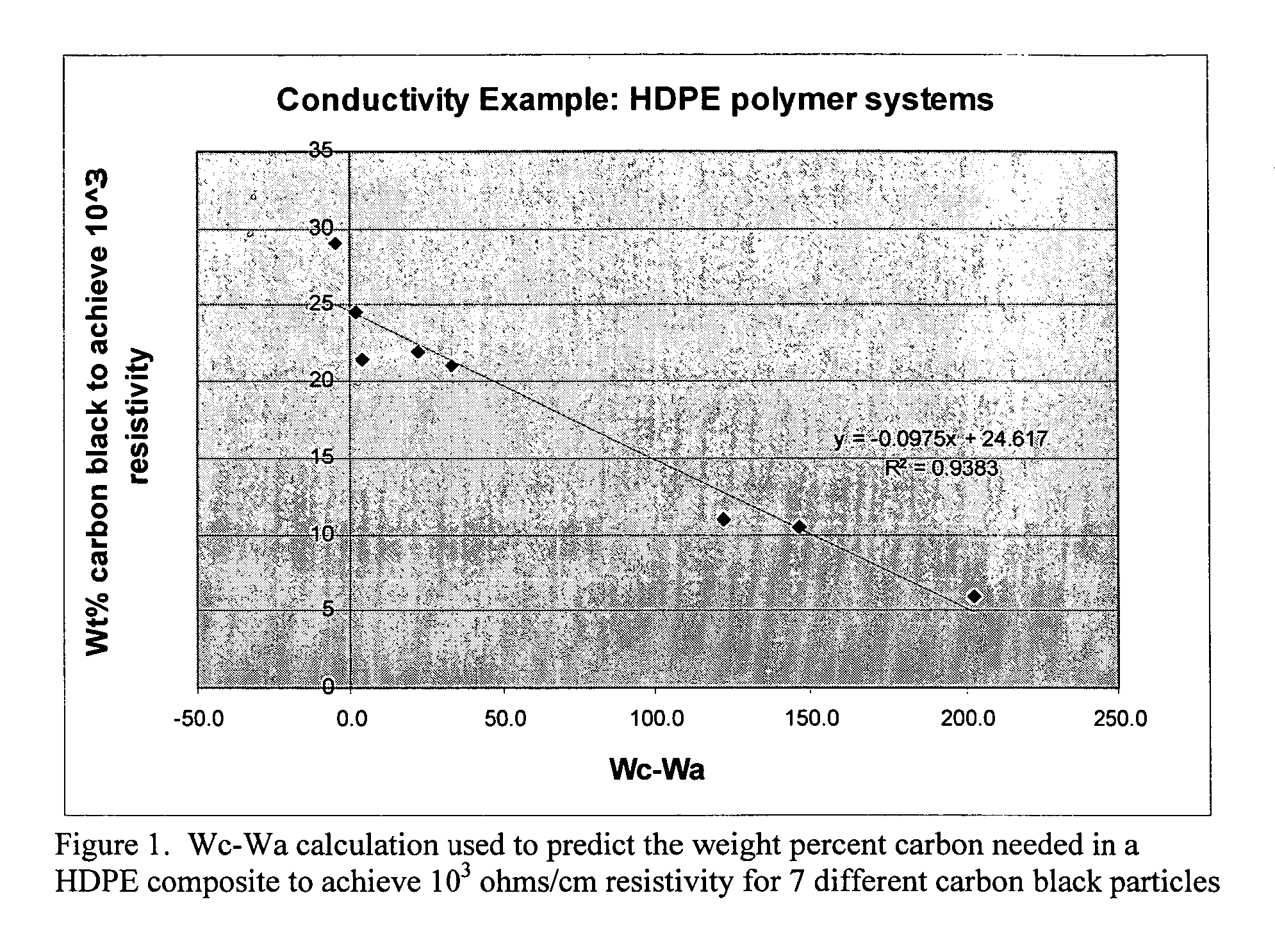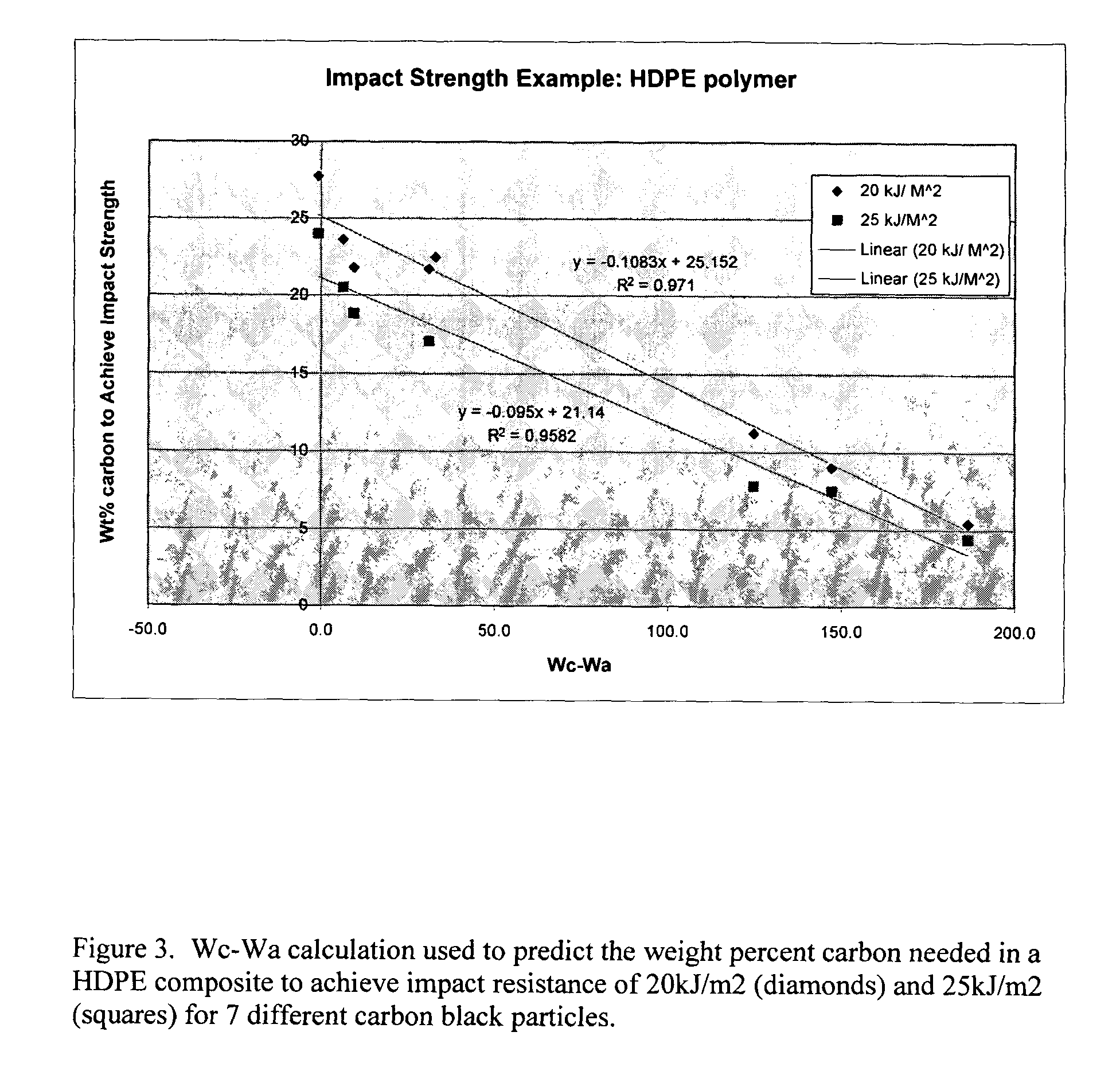Methods of selecting and developing a particulate material
a technology of particulate material and process, applied in chemical methods analysis, instruments, transportation and packaging, etc., can solve the problems of difficult selection of the best particulate for the composition of a customer or a particulate manufacturer, production undertaking a thorough and costly study of the process and product, and the product received did not perform as expected
- Summary
- Abstract
- Description
- Claims
- Application Information
AI Technical Summary
Benefits of technology
Problems solved by technology
Method used
Image
Examples
example 1
[0150]Standard grades of carbon black are available from various manufacturers. One of the Q / C specifications for these standard grades is the DBP number. The volume at maximum torque for dibutyl phthalate (DBP) is a QA / QC measure of the morphology of the carbon black.
[0151]The DBP value was measured on six standard grades in a Brabender mixer with a device having a means for recording the torque data. The data is reported in the Table 2 below. The carbon blacks are ordered by their DBP numbers.
[0152]Determining the volume at maximum torque for another liquid is an example of a QA / QC test for the interfacial potential of the carbon black, which may be used to specify the particulate material. For this example, water, a 60 / 40 ethylene glycol / water mixture (60 parts ethylene glycol by volume to 40 parts water by volume), ethylene glycol, and paraffin oil were used. The volumes at maximum torque are also shown in Table 2. These results show that standard grades order differently depend...
example 2
[0154]Manufacturers often produce the same product at different manufacturing plants. The products need to meet the product specifications regardless of where they are produced.
[0155]Table 3 shows data taken on the same grade of carbon black from four manufacturing plants. In this example the “% of max DBP” is the percentage of the maximum DBP value in the table, which was that of Plant E. The DBP numbers were measured as the volume at maximum torque on a Brabender abosrptometer with a device capable of recording the torque data. Note that the DBP values are nearly identical (within approximately 96% of the maximum value). The DBP values are part of the current product specification and by this criterion, all the samples would therefore be considered to be the same (i.e., within spec).
[0156]The volume at maximum torque was also measured for three other liquids: ethylene glycol (EG), 60 / 40 ethylene glycol / water (60 parts ethylene glycol by volume and 40 parts water by volume), and pu...
example 3
[0159]The carbon black of Example 2 had a low DBP value. A similar test was done for a grade of carbon black with a higher DBP specification. Samples were taken from three manufacturing plants. Again the volume at maximum torque with DBP was measured in a Brabender absorptometer with a device having a means of recording the torque data, and the results are shown as a percentage of the maximum value (Plant F). Results are shown in Table 4 below. The volume at maximum torque was also measured with ethylene glycol (EG), 60 / 40 EG / water (60 parts ethylene glycol by volume and 40 parts water by volume), and pure water, and the resulting data are also shown in Table 4.
[0160]
TABLE 4Volume @Max TorqueSample% of60%namemax DBPEGEGWaterPlant F100115.3150.5217.1Plant G98.3114.0141.5183.95Plant H97.2111.5138.9208.2Plant I97.5114.1139.6226.75
[0161]The data shows that when an interfacial potential property value is measured, the grades made in different plants are found to be different. Thus, inclu...
PUM
| Property | Measurement | Unit |
|---|---|---|
| vapor pressure | aaaaa | aaaaa |
| impact strength | aaaaa | aaaaa |
| quench length | aaaaa | aaaaa |
Abstract
Description
Claims
Application Information
 Login to View More
Login to View More - R&D
- Intellectual Property
- Life Sciences
- Materials
- Tech Scout
- Unparalleled Data Quality
- Higher Quality Content
- 60% Fewer Hallucinations
Browse by: Latest US Patents, China's latest patents, Technical Efficacy Thesaurus, Application Domain, Technology Topic, Popular Technical Reports.
© 2025 PatSnap. All rights reserved.Legal|Privacy policy|Modern Slavery Act Transparency Statement|Sitemap|About US| Contact US: help@patsnap.com



